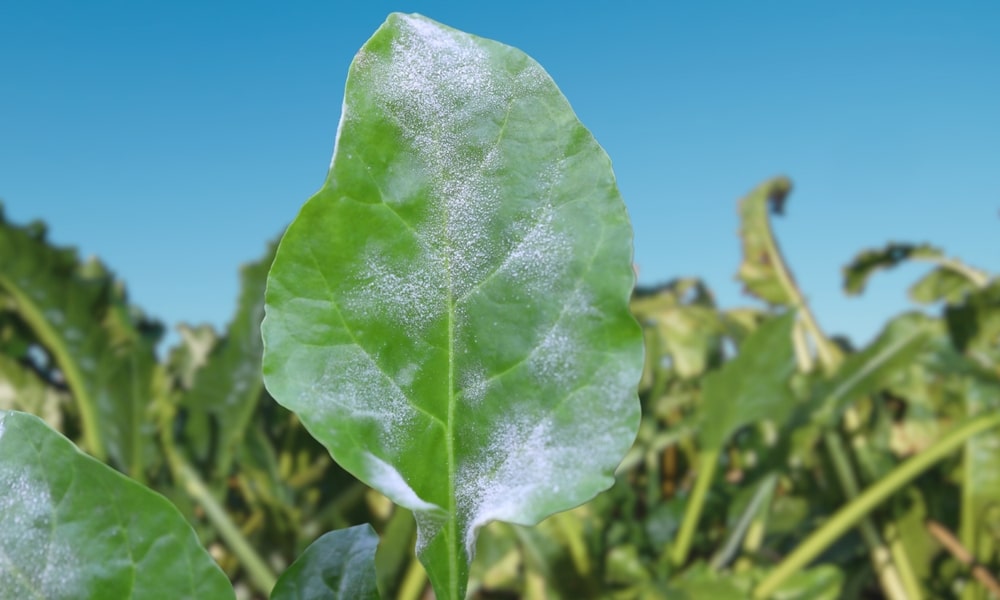
Powdery mildew is white or gray powdery spots, often times covering most if not the entire leaf surface. It’s also found on plant stems, flowers and even fruit. Fortunately, the symptoms of powdery mildew are usually worse than the actual damage. The plant rarely dies.
If you find that some of your plants or trees have powdery mildew, don’t worry. This fungus is host specific, meaning just because you find it on one plant species, does not make it a threat to other type plants in your landscape. Although there are many different species of powdery mildew, the symptoms all look about the same from one to another.
Advanced Stages of Powdery Mildew
Advanced stages can cause plant foliage to yellow, curl or turn brown and eventually cause the plant to defoliate prematurely. On flowering plants and trees, the fungus can lead to early bud drop or reduce the flower quality.
What Conditions Cause Powdery Mildew?
Conditions that favor mildew formation include dry foliage, high humidity, low light and moderate temperatures.
How to Prevent Powdery Mildew?
To help prevent powdery mildew, avoid over-fertilization. New growth is more susceptible. Instead, apply a slow-release fertilizer that provides more controlled growth.
How to Get Rid of Powdery Mildew
If you already have powdery mildew, early detection provides the best way to contain and potentially eliminate the problem. There are many commercial products that are effective at containing the spread.
DACONIL is a readily available fungicide that will help with the problem – be sure to follow label instructions exactly.
You may prefer the non-chemical route, and will want to try:
Neem Oil:
This is a readily available organic option to disease and pest control. Neem oil is extracted from the neem tree, native to India. This is an effective disease control and a broad spectrum, natural insecticide that is kinder to beneficial insects and mammals.
Water:
Ironically, dry conditions and high humidity are the most favorable conditions for powdery mildew to form. But straight water is its enemy because it washes off the spores before they have time to embed. However, water isn’t something that I promote for control because wet foliage is friend to many other plant diseases.
Baking Soda (sodium bicarbonate):
This is possibly the best known of the home-made, organic solutions for powdery mildew. Although studies indicate that baking soda alone is not all that effective, when combined with horticultural grade or dormant oil and liquid soap, efficacy is very good if applied in the early stages or before an outbreak occurs. Mix one tablespoon of baking soda with a teaspoon of dormant oil and one teaspoon of insecticidal or liquid soap (not detergent) to a gallon of water. Spray on plants every one to two weeks.
Potassium Bicarbonate:
Similar to baking soda, this has the unique advantage of actually eliminating powdery mildew once it’s there. Potassium bicarbonate is a contact fungicide which kills the powdery mildew spores quickly. In addition, it’s approved for use in organic growing.
Mouthwash:
Generic, ethanol based mouthwash can be very effective at control. Tests using one part mouthwash to three parts water worked well for Jeff Gillman, Ph.D and Associate Professor at the University of Minnesota, Department of Horticulture. Just be careful when mixing and applying mouthwash as new foliage can be damaged.
Vinegar:
Similar to mouthwash, the acetic acid of vinegar can control powdery mildew. A mixture of 2-3 tablespoons of common apple cider vinegar, containing 5% acetic acid mixed with a gallon of water does job. However, too much vinegar can burn plants but at the same time, higher concentrations (above 5%) are more effective.
Milk:
The latest player in the fight against powdery mildew is milk. It’s not clear yet why it works so well, but it is believed that naturally occurring compounds in the milk are at work to combat the disease while also boosting the plant’s immune system. One experiment showed good results by applying a weekly dose of one part milk to two parts water. This is yet another case when more is not better. Concentrations above three parts water had adverse side effects.
[From Joe Lamp’l http://www.growingagreenerworld.com/controlling-or-eliminating-powdery-mildew/]
Get Plant Help From Our Experts
Meadows Farms has a team of plant and landscaping experts available to help at 17 locations around Metro DC. Get answers to your questions.

